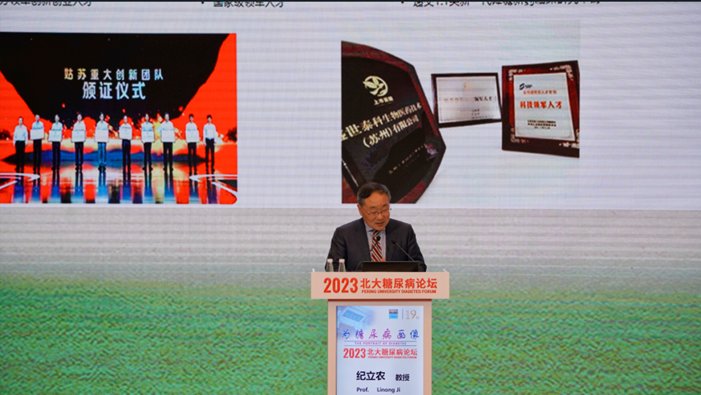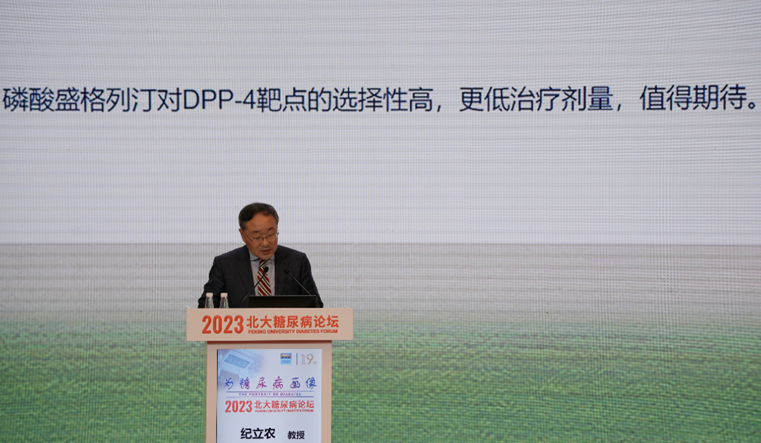International diabetes expert Professor Lino Ji explains the Phase 3 clinical data of sotagliflozin, a new-generation, highly selective DPP-4 inhibitor.
Release date:
2023-05-31
Recently, at the 19th Peking University Diabetes Forum, Professor Ji Linong, Chairman of this year’s conference and Director of the Department of Endocrinology at Peking University People’s Hospital, unveiled the data and results from two Phase III clinical trials of senglitinib. As a next-generation, highly selective DPP-4 inhibitor independently developed by Shengshi Taike, senglitinib demonstrated exceptionally favorable efficacy and safety profiles compared to existing similar drugs on the market, positioning it as a promising, domestically produced, first-in-class new antidiabetic drug for type 2 diabetes treatment.

Professor Ji Linong delivers a presentation at the Peking University Diabetes Forum.
Sheng Gliflozin was previously shortlisted for the national "Major New Drug Development" initiatives during both China's 12th and 13th Five-Year Plans. Due to the outstanding data demonstrated in the head-to-head Phase 1 clinical trial compared to the market's leading product, Granted exemption to move directly from Phase II clinical trials into Phase III clinical trials. Before submitting the NDA, Shengshi Taikang conducted two Phase III clinical trials in China evaluating sengliptin and sengliptin combined with metformin for the treatment of type 2 diabetes, led as the Principal Investigator by Professor Li-Nong Ji, Director of the Department of Endocrinology at Peking University People's Hospital, Director of the Peking University Diabetes Center, and Chairman of the International Diabetes Federation’s Western Pacific Region.
Two Phase 3 clinical trials of sitagliptin enrolled nearly 1,000 participants. The sitagliptin monotherapy trial included patients with type 2 diabetes who had never received any prior medication, while the sitagliptin plus metformin combination therapy trial targeted patients whose blood sugar control remained inadequate despite monotherapy with metformin alone. Both studies were randomized, double-blind, placebo-controlled trials, with participants randomly assigned to receive either a placebo, 50 mg of sitagliptin, or 100 mg of sitagliptin.
The trial results showed that, in the monotherapy trial with sotagliflozin, the 50mg and 100mg dose groups achieved HbA1c reductions of 1.07% and 1.08%, respectively, by Week 24. In the combination therapy trial of sotagliflozin plus metformin, the 50mg and 100mg dose groups demonstrated HbA1c reductions of 1.17% and 1.23%, respectively, at Week 24. Additionally, data from both trials indicated that patients with higher baseline blood glucose levels experienced greater reductions in HbA1c.
In the 28-week trial comparing sitagliptin monotherapy with combination therapy, data consistently demonstrated sustained and stable reductions in participants' HbA1c levels. Meanwhile, the 100mg dose group (high-dose group) showed excellent drug safety when compared to the placebo group, with an adverse reaction rate similar to that of the placebo group.

Professor Ji Linong delivers a presentation at the Peking University Diabetes Forum.
Professor Ji Linong noted in his clinical summary: "Clinical trial data for sitagliptin 50mg—both as a monotherapy at low dose and in combination therapy—demonstrate significant improvements in HbA1c levels across patients with varying durations of diabetes history, highlighting substantial clinical relevance. Additionally, the drug markedly improved β-cell function and reduced systolic blood pressure. In terms of safety, sitagliptin did not reveal any additional safety concerns compared to placebo." Therefore, sotagliflozin demonstrates excellent efficacy and safety. "Hopefully, it will soon provide clinicians like us with more diabetes treatment options."
Professor Hong Tianpei, Vice Chairman of the Endocrinology Branch of the Chinese Medical Association, who was responsible for chairing the forum, also stated on the spot: "As a Class 1.1 novel drug independently developed by a Chinese company, Starglitin has delivered exceptionally promising clinical data—particularly notable is its ability to skip Phase II trials and move directly into Phase III. Even more impressive is the comparative analysis between the two dosage groups, which highlights the advantage of a lower effective dose and enhanced safety profile. We’re eagerly anticipating this product’s early market launch."
As DPP-4 inhibitors continue to gain popularity in China, the market for these drugs—all of which are imported—reached nearly 10 billion RMB in 2022. Currently, the combination of metformin with GLP-1 receptor agonists has become the primary treatment approach for type 2 diabetes in clinical practice. According to a research report by Sullivan, by 2030, GLP-1 receptor agonists are expected to surpass a market value of 30 billion RMB in China, highlighting their promising growth prospects.
Mr. Ding Juping, Co-founder and President of Shengshi Taikang, said: "We are thrilled to see that the 50mg formulation of shengglietin, developed by our company, has successfully completed Phase III clinical trials." "Remarkably effective treatment results with half the effort—this could position it as the best-in-class new drug for blood sugar control." "Hopefully, it will be approved for market launch soon, bringing much-needed relief to the vast number of diabetes patients in China."
Prev:
